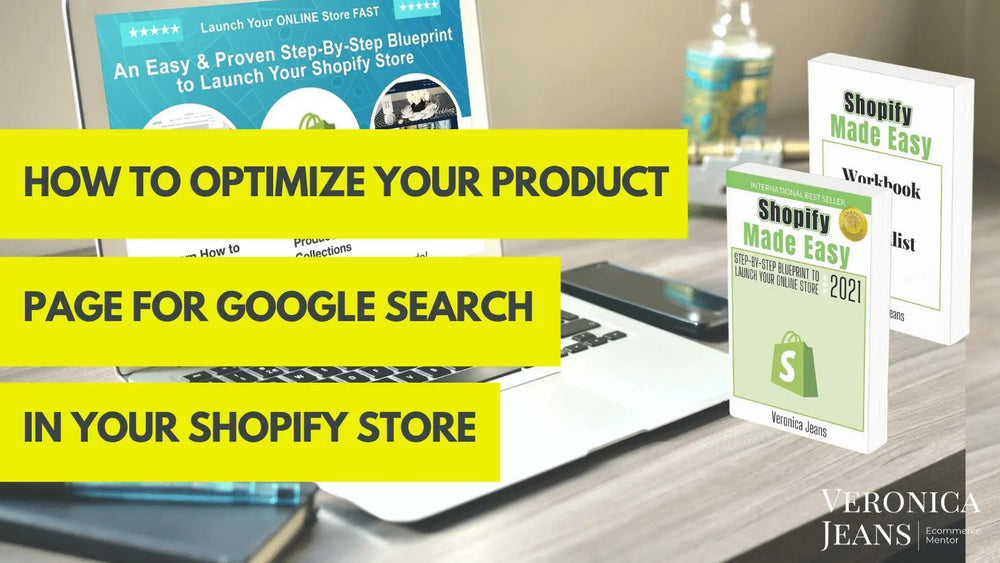8. How To Optimize Your Product Page For Google In Shopify #12

8. Search Engine Listing Preview
I will show you step-by-step actions on how to add the information and some tips for each section.
What are a meta title and description tag?
The meta title and description is an HTML attribute that provides a brief summary of a web page. Search engines such as Google display the meta title and description in search results where they can highly influence users to click through to your pages.
Shopify will create your page title, description, and handle automatically when you add your title and description.
You can change your information to your best advantage.
So check each page and make sure your message is what you want prospective buyers to see on Google.
Step 1.
To view or change your ‘search engine listing preview’, click on ‘Edit website SEO’ at the bottom of the product, collection or pages sections in your Admin.

Now you can change your information for your search engine listing on Google, Bing, Yahoo etc.

The example below is how your ‘Search Engine Listing Preview’ will show up on Google and other search engines.

Step 2. Page Title
You can use 70 characters - use them.
You might not want the exact title in your preview description for two reasons:
- The collection title may be too long.
- And you only have 70 characters on Google search to show your page to the best advantage.
Step 3. Description
You can use 0 - 320 characters - use them. Make sure you use your best information in the first 160 characters.
The description is automatically added to your preview description.
Remember, make your description logical for the customer, so they will take action when reading your description. Check out other companies and see what and how they write their descriptions.
If you don’t have a description for your page, there will be no description in the preview. It is advisable to add a preview description for your search engine listing.
Step 4.URL and handle

What your URL looks like is important. Your URL is your website address on the web. It’s the most direct way for someone to visit a page on your website.
URL – Uniform Resource Locator
Here are some key reasons for a great URL structure:
- The URL is one of the most important parts of the page Google looks at to determine what a page is about.
- It is easier to navigate for users. If someone is browsing in your store and finds themselves on the page, www.store.com/collections/women/dresses/evening-wear, they know they are on a collection page for dresses and the dresses are evening wear. But they can then easily navigate back to the main page for dresses.
- The search engine bots can easily make the relevant connections between different pages on your store – it can see that a particular item belongs in the same collection as other dresses (even if “dress” isn’t in the product name), which belong in the larger collection of women’s clothes on the site – information that helps the search bot better understand what different sections of the store are about and how they relate to each other.
This is the reason to edit the URL and make sure that it makes sense.
An example:
The title on the page is - ADIDAS FLX24 COMPO 6 FIELD HOCKEY STICK
The automatic generated URL for the product page is - https://justhersports.myshopify.com/products/adidas-flx24-compo-6-field-hockey-stick.
This is a great URL because a search for the product is what a prospective buyer will look for. Can we make it shorter? Sure, but again, it is the keyword phrase used in the Search engines but people who are looking for the product.
6 KEY ELEMENTS TO A GREAT URL (Uniform resource locator)
- Keep your URL short and simple. Try not to keyword stuff. If a visitor wants to save the URL, it has to be easy to remember.
- Don’t add unnecessary words or characters.
- You cannot use just spaces. For each space, ‘20%’ will be added which obviously makes the URL difficult to read.
- Use hyphens to separate words. This will signal to Google where the breaks between words are, and make it easier for your visitors to understand URLs than if the words all ran together.
- Remove stop words like a the, and, or, but, an, of, etc. To keep it short and simple, take out these words when the URL is automatically generated by Shopify.
- Make sure you are using a Primary Keyword in your URL.
I hope the two bonus chapters will be a great help to understand just some of the aspects of your store and the benefits of including them in this book.

Veronica Jeans
eCommerce Strategist | Shopify Expert | 7-Figure Business Coach
I have integrated my extensive knowledge in the field of eCommerce and Shopify, along with my international financial expertise, to offer up a playbook for generating income online.

